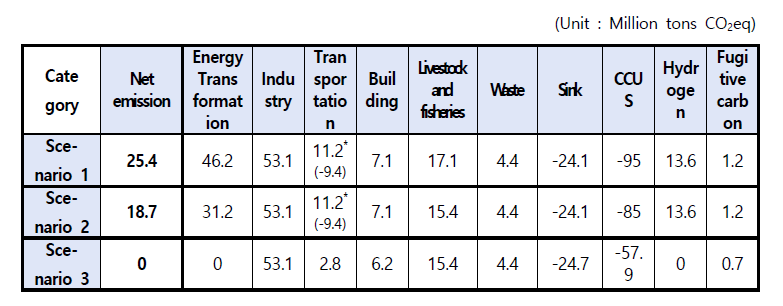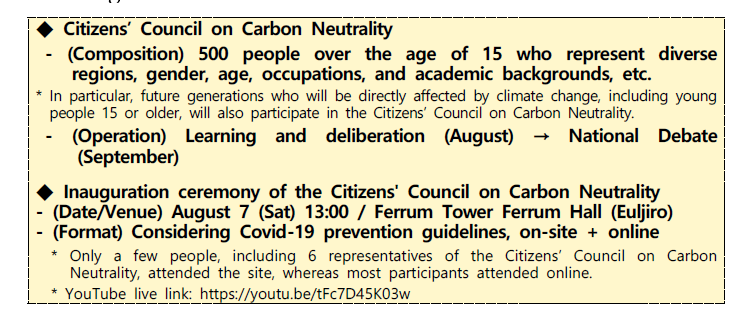□ The Commission set the vision of the carbon-neutrality Scenarios as “a carbon neutrality society that is safe and sustainable from the climate crisis” and reviewed the Scenarios based on five principles: responsibility, inclusiveness, fairness, rationality, and innovation.
□ The following are the Scenario drafts released today:
▴Scenario 1 - which considers technological development and conversion of raw materials and fuel while maximizing the existing system and structure;
▴Scenario 2 - which reduces fossil fuels and further reduced the greenhouse gas(GHG) emissions from Scenarios 1 through lifestyle changes;
▴Scenario 3 - which drastically reduces fossil fuels and converts the entire supply of hydrogen to green hydrogen.
There are three different versions of the Scenarios :
ㅇ Each alternative assumes different key reduction measures such as (energy transformation) coal-fired power generation, (transport) electric and hydrogen vehicle ratio, (building) building energy management, CCUS and the number of secured carbon sinks. The net-zero GHG emissions under these three different Scenarios are as follows: 25.4 million tons under Scenario 1, 18.7 million tons under Scenario 2, and net-zero emissions under Scenario 3.

* Some of the emissions from the transportation sector are emissions (9.4 million tons) from alternative fuels (e-fuel, etc.), but it is assumed that the same amount of emissions is captured and offset by GHG emissions during the production of alternative fuels.
□ The main contents of each Scenario by sector are as follows.
<① Energy Transformation>
□ Energy transformation is the sector with the largest disparity among all of the sectors evaluated by this initiative, and a total of 269.6 million tons of GHG emissions in 2018 were reduced by 82.9% to 100% for each alternative, resulting in 46.2 million tons of emissions under Scenario 1, 31.2 million tons under Scenario 2, and 0 under Scenario 3.
□ Scenario 1 assumes that seven coal-fired power plants that will not reach their operational lifetime limit by 2050 will still be operated: Scenario 2 assumes that coal-fired power generation should be terminated, but LNG power generation would be utilized as a flexible power source in response to urgent demand. Scenario 3 assumes a plan to increase the proportion of renewable energy supply and stop* all coal and LNG power generation.
* Coal and LNG facilities will be replaced with hydrogen and ammonia power plants, alternatively new laws and compensation measures could also be implemented.
ㅇ The policy recommendations for the implementation of the Scenarios in the energy conversion sector included: “expansion of renewable energy use”; “Securing the stability of the renewable energy-oriented power supply system”; and “Utilization of cutting-edge digital technology to reduce electricity demand, and to ensure the participation of all citizens.”
<② Industry>
□ The industrial sector's emission forecast for 2050 is 53.1 million tons, which represents a 79.6% reduction from the total emission of 260.5 million tons in 2018.
ㅇ The main reduction measures were assumed to include conversion of all blast furnaces in the steel industry to electricity, an introduction of electric heating furnaces in the petrochemical and oil refining industries, fuel conversion(e.g. : replacement of conventional boilers with biomass boilers), and the promotion of energy efficient technologies in industries that consume substantial amounts of electricity such as semiconductors, displays, and the electric and electronic industries.
ㅇ The policy recommendations for the implementation of the Scenarios in the energy transformation sector included: "expansion of investment in technology development and facility improvement"; “promoting GHG reduction through the emission trading scheme(ETS) and green finance”; and "minimizing adverse outcomes such as job loss".
<③ Transportation>
□ The transportation sector's 2050 emissions forecast projects a reduction of 88.6% to 97.1% compared to the total emissions of 98.1 million tons in 2018 under Scenarios 1 and 2 with 11.2 million tons (※ 9.4 million tons offset*), and 2.8 million tons under Scenario 3.
* Of the emissions (11.2 million tons) in the transportation Scenarios 1 and 2, the amount of emissions (9.4 million tons) resulting from the use of E-fuel for vehicles is offset by the capture and utilization of GHG during the production of alternative fuels.
ㅇ The main difference between Scenarios 1,2 and 3 is the supply of electric and hydrogen vehicles, as Scenarios 1 and 2 assume that 76% of vehicles will be electric and hydrogen powered, whereas Scenario 3 assumes a 97%.
ㅇ To this end, proposals were made to expand the supply of pollution-free vehicles(e.g. electric and hydrogen vehicles), to strengthen the management of transportation demand(e.g. expanding public transportation), as well as switching to eco-friendly railroads and shipping.
<④ Building>
□ The building sector's emission forecast for 2050 is 7.1 million tons under Scenarios 1 and 2, and 6.2 million tons under Scenario 3, which constitutes an 86.4% ~ 88.1% reduction compared to the 52.1 million tons emitted in 2018.
ㅇ In contrast to Scenarios 1 and 2, Scenario 3 is based on the premise of further reducing gas emitted from cities by using renewable energy (hydrothermal) as heat sources for district heating.
ㅇ To achieve these reductions, the improvement of building energy efficiency and manage demand has been proposed. This includes the spread of green remodeling, the expansion of zero-energy building certification targets, and the introduction of a surplus electricity trading system among individuals.
<⑤ Livestock and Fisheries>
□ The projected emissions for 2050 in the livestock and fishery sector are 17.1 million tons (Scenario 1) and 15.4 million tons (Scenarios 2 and 3), which represents a 31.2% to 37.7% decreased from the 24.7 million tons emitted in 2018.
ㅇ Emissions are expected to be reduced through a series of strategies, including ▲ the improvement of farming methods that minimize or eliminate methane and nitrous oxide generation; ▲ the enhancement of livestock productivity through the reduction of mortality; and ▲ changes in diet and expansion of alternative processed foods, etc.
<⑥ Waste>
□ Reduction of waste is projected to reach 4.4 million tons in 2050, which is a 74% reduction compared to the 17.1 million tons emitted in 2018, such as through restrictions on the use of disposable products and promoting the use of recycled raw materials.
<⑦ Sinks>
□ As of 2018, the amount of GHG absorbed through sinks was 41.3 million tons, and in the absence of strengthened forestry measures, the absorption capacity of forests in 2050 is expected to reach only 13.9 million tons. The expected absorption under the 2050 Carbon Neutrality Scenarios is 24.1 million tons under Scenarios 1 and 2, and 24.7 million tons under Scenario 3.
< ⑧ CCUS >
□ CCUS technology captures, stores, and utilizes emitted GHG. It is projected that these technologies would allow for the absorption of 95 million tons (Scenario 1), 85 million tons (Scenario 2), and 57.9 million tons (Scenario 3) through investment expansion and technological development.
* CCUS : Carbon Capture, Utilization and Storage
<⑨ Hydrogen>
□ The demand for hydrogen is projected to increase by 2050. Assuming that hydrogen is supplied through extraction from LNG, etc., 13.6 million tons of GHG (Scenarios 1 and 2) are expected to be emitted. However, gas emissions would decrease to zero, if we assume that only green hydrogen will be used (Scenario 3).
□ The Commission plans to conduct extensive consultations on three draft Scenarios released today by September.
ㅇ In addition to the opinions of various sectors such as industry, labor, civil society, youth, and local governments, opinions from the general public will also be considered through the Citizens’ Council on Carbon Neutrality, which will be launched on August 7th.

ㅇ Additionally, the Commission plans to conduct discussions among Ministries, when collecting opinions on major reduction measures and policy proposals in the draft Scenarios, as well as review the potential ripple effect of each proposal.
□ The Commission also plans to announce the final Government draft at the end of October after reviewing opinions of stakeholders and the general public, following the decisions of the Commission and the cabinet meeting.
